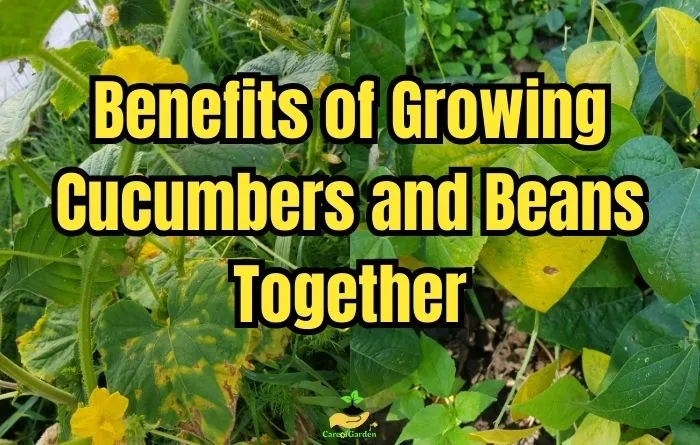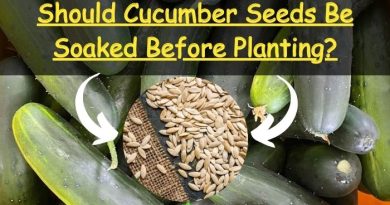Can Cucumber and Beans Grow Together? Answered!
Many gardeners wonder if cucumber and beans can be grown together in the same garden bed. In this blog post, I’ll share my top tips for successfully growing cucumber and beans together including the best varieties to choose, how to provide support and provide tips for successful companion planting.
Key Takeaways:
- Cucumbers and beans can be grown together as companion plants.
- Beans are nitrogen-fixing plants that enrich the soil and promote healthy cucumber growth.
- Cornstalks can provide support for vining cucumbers, while smaller fruit varieties are more suitable for interplanting.
- Dill, marigolds, nasturtiums, carrots, beets, borage, chives, oregano, and sunflowers are good companion plants for cucumbers.
- Companion planting reduces pests, attracts pollinators, and increases yields.
Can Cucumber and Beans Grow Together?
Yes, cucumber and beans can grow together in the same garden bed. In fact, they can even benefit from each other’s presence. Cucumber plants can act as a living trellis for climbing bean plants, while the beans can fix nitrogen in the soil, which benefits the cucumber plants.
For instance, cucumbers and beans are compatible as they have symbiotic relationships. Beans are nitrogen-fixing plants, which means they have the ability to convert atmospheric nitrogen into a form that is easily absorbed by plants. This in turn benefits cucumbers, which require a steady supply of nitrogen for optimal growth.
Cucumbers and beans have different root systems, so they can easily grow next to each other. Cucumbers plants have shallow roots, while beans plants have deep roots that reach deep into the soil. This means that plants will not compete for nutrients and water in the soil.
In addition, beans are a nitrogen-fixing crop, meaning they are able to capture atmospheric nitrogen and convert it into an available form for plants. Cucumbers, in turn, require large amounts of nitrogen for growth and development. Therefore, by growing cucumbers and beans together, you can reduce fertilizer costs and improve soil quality.
However, it must be taken into account that beans can be taller than cucumbers, so it is necessary to provide the beans with support to support the plant. You can also remove the lower leaves of the beans to provide adequate light and air for the cucumbers.
Overall, growing cucumbers and beans together can be beneficial for your garden by reducing fertilizer costs and improving soil quality.
Companion plants not only offer practical benefits but also enhance the visual appeal of your garden. Their combined presence can create a diverse and harmonious ecosystem, resulting in healthier and more productive cucumber and bean plants.
The Benefits of Growing Cucumbers and Beans Together

There are numerous benefits to growing cucumber and beans together in your garden, both for the plants themselves and for your overall harvest.
By interplanting these two vegetables, I can create a symbiotic relationship that promotes growth, enhances pollination, and improves soil fertility.
| Benefits of Growing Cucumbers and Beans Together | Summary |
|---|---|
| 1. Nitrogen Fixation | Beans enrich the soil with nitrogen, promoting healthy cucumber growth. |
| 2. Provide Natural Shade | Cucumber vines provide shade, keeping bean roots cool during hot summer months. |
| 3. Maximizing Garden Space | Vertical growth habits of cucumber and beans allow for trellising and intercropping, maximizing overall yield. |
| 4. Natural Pest Control | Planting cucumbers and beans together can deter certain pests. The diversity of plants in close proximity confuses and repels specific insects, reducing the risk of infestation. |
| 5. Weed Suppression | The dense foliage of both cucumbers and beans helps suppress weed growth, reducing the need for manual weeding. |
https://web.uri.edu/wp-content/uploads/sites/336/P2-Companion-Planting.pdf
1. Nitrogen Fixation
One of the key benefits of growing cucumber and beans together is the nitrogen-fixing ability of beans. As legumes, beans have the unique ability to convert atmospheric nitrogen into a form that plants can use.
This process, known as nitrogen fixation, enriches the soil with this essential nutrient, which in turn promotes healthy cucumber growth. I’ve noticed that the combination of these two plants can result in lush, vibrant cucumber plants with improved yields. It’s a win-win situation that I highly recommend!
2. Provide Natural Shade
Another advantage of co-planting cucumber and beans is the natural shade provided by the cucumber vines. I’ve noticed that cucumber plants have large, sprawling leaves that create a cooling effect on the ground below.
This shade can help keep the roots of the bean plants cool during hot summer months, reducing stress and improving overall plant health. It’s a great way to maximize garden space and create a natural microclimate that benefits both plants. I highly recommend giving it a try!
3. Maximizing Garden Space
Companion planting cucumber and beans also offers the opportunity to maximize garden space. Both vegetables have a vertical growth habit, making them ideal candidates for trellising or intercropping.
When intercropping cucumber and beans, it’s essential to choose the right varieties that are compatible in terms of size and growth habits. Vining cucumbers can be trained to climb cornstalks or trellises, allowing them to reach for the sky and save horizontal space.
On the other hand, smaller bush varieties of cucumbers are more suitable for interplanting, as they require less vertical support and can be grown amidst the bean plants.
Intercropping Cucumber and Beans: Table with Recommended Planting Distances:
| Crop | Planting Distance (inches) |
|---|---|
| Cucumbers | 12-18 |
| Beans | 12-18 |
I use cornstalks or sturdy trellises to support my climbing cucumbers, turning the vertical space into a green paradise and significantly boosting my overall yield.
But here’s another smart move: I also plant smaller bushy cucumbers right in between my bean plants. This dual approach optimizes every inch of my garden and ensures these plant buddies grow harmoniously. It’s like a space-saving magic trick!
4. Natural Pest Control
In addition to these benefits, companion planting cucumber and beans can also have positive effects on pest control and pollination. Cucumbers, with their vibrant scent and prickly vines, are a natural deterrent for common pests like aphids and cucumber beetles. They help keep these unwanted critters at bay.
Beans, on the other hand, are like the strong, silent bodyguards of the garden. They naturally repel nematodes, which are notorious for causing trouble in the soil.
Additionally, attracting pollinators, like bees and butterflies, to your garden through companion planting can enhance the pollination process and increase fruit set.
| Pest | Prevention |
|---|---|
| Cucumber beetles | Plant marigolds or nasturtiums nearby to repel beetles. |
| Aphids | Introduce beneficial insects like ladybugs or lacewings to control aphid populations. |
| Spider mites | Regularly spray plants with a strong jet of water to dislodge mites, or use insecticidal soap. |
5. Weed Suppression
Cucumber vines and bean plants create a thick canopy that shades the soil beneath. This shading not only reduces sunlight access to weed seeds but also limits their space to grow. Consequently, I spend less time battling weeds and more time enjoying a well-maintained garden.
In this cooperative planting strategy, cucumbers and beans work together to keep my garden clean and weed-free, making the gardening experience much more pleasant.
What varieties of cucumbers are compatible with beans?
When I’m considering companion planting for cucumbers and beans in my garden, I always pay attention to selecting cucumber varieties that complement the beans.
Here are some cucumber options that I’ve found grow harmoniously with bean plants:
- Bush Cucumbers: I’ve had great success with compact bush cucumber varieties like “Spacemaster” or “Picklebush.” Their manageable size allows them to coexist with beans without taking over the garden.
- Pickling Cucumbers: For a thriving cucumber and bean partnership, I often choose pickling cucumber varieties such as “National Pickling” or “Boston Pickling.” These cucumbers are smaller in size, produce abundantly, and perfectly complement beans.
- Slicing Cucumbers: While not as compact as bush cucumbers, slicing cucumber varieties like “Marketmore” or “Straight Eight” can also be a great choice. I ensure there’s sufficient space to accommodate their vining growth alongside beans.
- Asian Cucumbers: Space-efficient cucumber varieties like “Suyo Long” or “Japanese Long” have found a spot in my garden. They’re slim and vertical, making them excellent companions for beans in my vertical gardening setup.
- Lemon Cucumbers: On occasion, I like to add a touch of variety with lemon cucumbers, known for their round, yellow fruit. They too make for a delightful companion to bean plants.
How to Grow Cucumber and Beans Together
I’ve had great success growing cucumbers and beans together in my garden. Here are the steps I follow:
1. Choose a sunny location: As an experienced gardener, I know that both cucumber and bean plants need at least 6-8 hours of direct sunlight per day to thrive. Choose a sunny location in your garden that receives plenty of sunlight throughout the day.
2. Prepare the soil: Cucumber and bean plants prefer well-draining soil that is rich in organic matter. Before planting, amend the soil with compost or aged manure to improve soil fertility and drainage.
3. Plant the seeds: Plant the cucumber and bean seeds according to the instructions on the seed packet. For cucumber seeds, plant them 1 inch deep and 12-24 inches apart. For bean seeds, plant them 1-2 inches deep and 4-6 inches apart.
4. Space the plants: When planting cucumber and beans together, it is vital to consider the spacing requirements for each plant.
Cucumbers are vining plants that require adequate space to spread out and climb. Allow at least 3 to 4 feet between cucumber plants to provide ample room for growth.
Beans, on the other hand, can be planted closer together, typically with 6 to 8 inches between plants. This spacing will ensure that both plants have sufficient access to sunlight, water, and nutrients.
5. Provide support: Since both cucumbers and beans are climbers, it’s essential to offer vertical support. You can use trellises, stakes, or even teepees made from bamboo or other materials. This vertical growth minimizes the use of space and increases yields.
6. Water regularly: Cucumber and bean plants need consistent moisture to grow and produce fruit. Water the plants deeply once or twice a week, depending on weather conditions.
Avoid overhead watering, as this can promote fungal diseases. Water deeply and thoroughly, ensuring that the water reaches the root zone. Mulching around the plants can help retain soil moisture and suppress weed growth. Ensure that the soil is well-draining to prevent waterlogging, which can lead to root rot.
7. Fertilize: Cucumber and bean plants benefit from regular fertilization throughout the growing season. Before planting, enrich the soil with organic matter such as compost or well-rotted manure.
Use a balanced fertilizer, such as a 10-10-10 or 20-20-20, and apply according to the instructions on the package. Incorporate a balanced granular fertilizer into the soil to provide additional nutrients throughout the growing season.
8. Harvest regularly: As the cucumber and bean plants produce fruit, harvest them regularly to promote continued growth and prevent over-ripening. Cucumbers should be harvested when they are 6-8 inches long, while beans should be harvested when they are young and tender.
How far apart to plant cucumbers and beans?
Proper spacing is crucial when planting cucumber and beans together. A general spacing guideline is to plant cucumbers and beans at least 12-18 inches apart to allow sufficient airflow and prevent overcrowding.
This spacing not only helps with pest and disease control but also ensures that each plant receives an adequate amount of sunlight and nutrients. Cucumber plants also benefit from the shade created by the bean plants, especially during hot summer months.
What is the best trellis for beans and cucumbers?
From experience, I can tell you that the best trellis for beans and cucumbers is one that is sturdy, tall, and has enough space for both plants to climb. Here are some options to consider:
- A-Frame Trellis: This type of trellis is easy to build and provides ample space for both beans and cucumbers to climb. It consists of two vertical posts that are connected at the top by a horizontal beam, forming an A-shape. You can attach twine or wire mesh to the horizontal beam to provide support for the plants.
- Teepee Trellis: This is another easy-to-build trellis that provides plenty of space for both beans and cucumbers to climb. It consists of three or four long poles that are tied together at the top to form a teepee shape. You can attach twine or wire mesh to the poles to provide support for the plants.
- Fence Trellis: If you have a fence in your garden, you can use it as a trellis for beans and cucumbers. Simply attach twine or wire mesh to the fence and train the plants to climb up it.
- Cattle Panel Trellis: This type of trellis is more expensive than the previous options, but it provides a sturdy and durable support system for both beans and cucumbers. Cattle panels are made of heavy-duty wire mesh and can be bent into an arch or tunnel shape to provide ample space for the plants to climb.
Can you grow pole beans and cucumbers on the same trellis?
Yes, you can definitely grow pole beans and cucumbers on the same trellis. In fact, it’s a smart gardening technique known as companion planting. Both cucumbers and pole beans are climbers, and they often complement each other. The beans can provide some shade to the cucumbers’ roots, while the cucumbers can help keep the soil around the beans moist.
However, there are a few things to consider. First, make sure your trellis is sturdy enough to support the weight of both plants. Cucumbers, in particular, can become heavy as they produce fruit. Reinforcing the trellis might be necessary.
Second, you’ll need to train and prune the plants as they grow. Both cucumbers and beans tend to reach for the sky, so guiding them along the trellis and keeping their growth in check is essential.
Lastly, ensure your garden receives plenty of sunlight, as both cucumbers and beans thrive in full sun.
Conclusion
In conclusion, planting cucumber and beans together is a wise choice for any vegetable gardener looking to maximize productivity and create a symbiotic environment for their plants.
By co-planting these two vegetables, gardeners can harness the benefits of companion planting. Beans, such as peas and other legumes, are nitrogen-fixing plants that naturally improve the soil by adding essential nutrients. This nutrient boost benefits cucumbers, promoting healthier growth and higher yields.
Frequently Asked Questions
When interplanting cucumber and beans, consider the size and growth habits of each vegetable. Vining cucumbers may benefit from support like cornstalks, while smaller bush varieties are more suitable for interplanting.
Intercropping cucumber and beans is an effective way to make the most of limited garden space while providing mutual support and protection against pests.
While cucumber and beans can thrive as companion plants, both vegetables are susceptible to pests and diseases. Implementing preventive measures such as crop rotation and regular monitoring is important.
Yes, interplanting cucumber and beans can increase overall yield by promoting healthier growth, enhancing pollination, and improving soil fertility.




